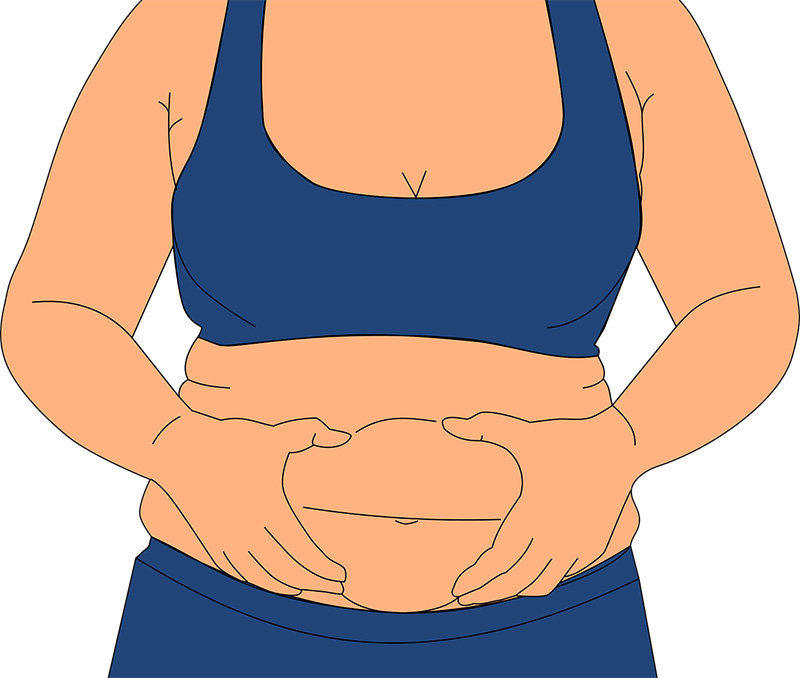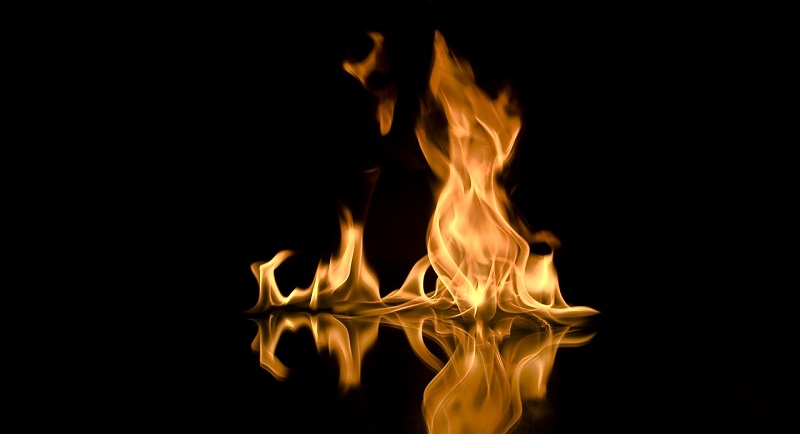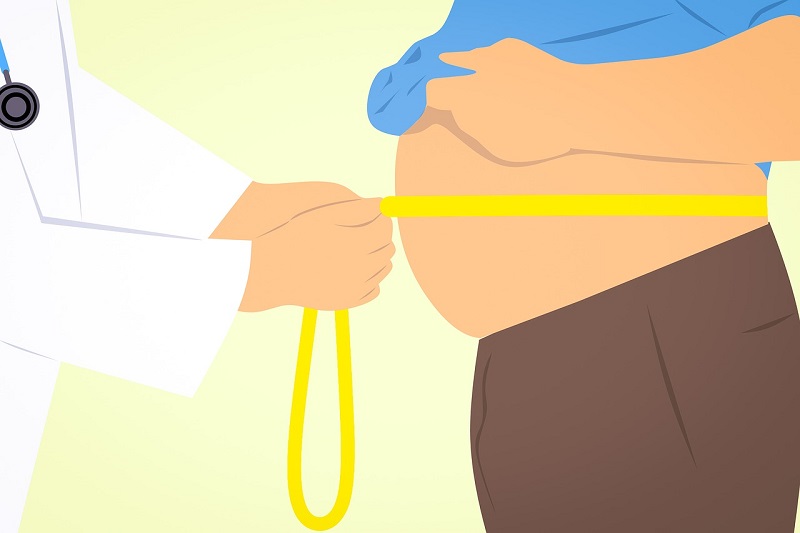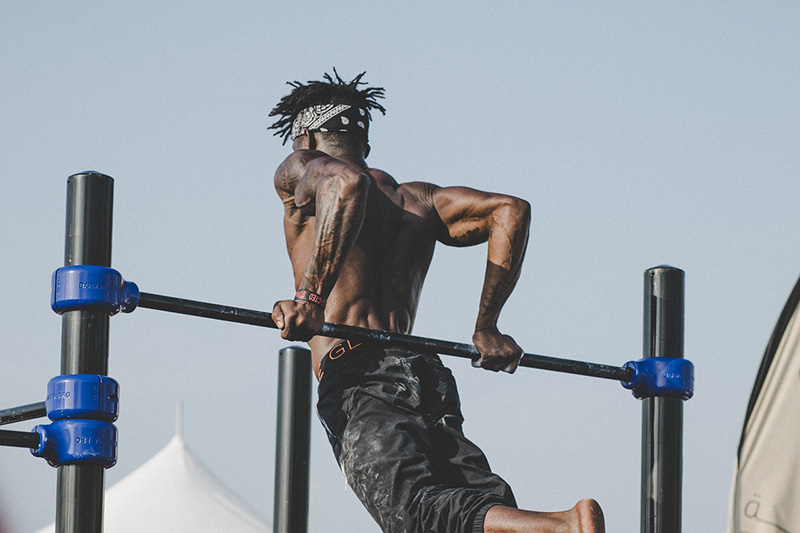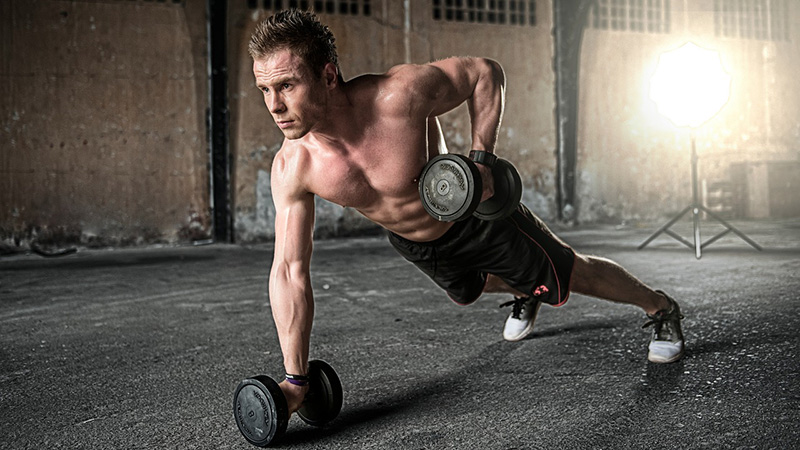Sixpack - Lose your belly fat and get taut muscles!
Fat reduction and muscle building - Why can't I get rid of my abdominal fat?
After a longer break we finally did our daily workout again today. At the moment we concentrate on our abdominal muscles, which neither Heiko nor I are really satisfied with. For some reason some abdominal fat has accumulated lately, while the once so tight muscles are now hardly visible. This was not allowed to stay like this! We needed methods for effective fat reduction and muscle building.
Motivated for this kind of training was an encounter we had shortly before on the beach. Here a young sonnyboy with a cigarette in his mouth and a Red Bull can in his hand came towards us and had a 1-A washboard stomach that made us green with envy. How could it be that someone who just hangs around on the beach all day long and places as much importance on his health as a possum places on its fur smell, had an optimal stomach? We, on the other hand, felt like two raccoons before hibernation despite the daily training, running and nutritional guidelines. So what's the end of that now!
But how should we approach the matter?
To answer this question, we did some research in addition to training. We found some exciting information about how abdominal fat is formed, why it is so difficult to break down and why the abdominal muscles like to play hide and seek. A relatively good short summary we found here in this video from Coach Cecil. Below we will go into this topic in more detail.
https://youtu.be/fBngxxRamqA" alignment="" width="700" height="400" autoplay="false" api_params="&rel=0" hide_on_mobile="small-visibility,medium-visibility,large-visibility" class=""]Why is it so hard to get rid of fat pads?
In order to understand this, one must first of all know how our body deals with fat reserves and fat pads. There is a significant structural difference between the fat build-up and the fat breakdown phase.
When building up fat, our body is very much oriented towards our emotional state. This means that certain emotions and basic moods ensure that our body fat is stored in certain places. There are some particularly popular main points that are very common in our society. Here it is important to know that this is different for men and women.
Problem zone: bottom, hips, thighs
A popular region for women is for example the area around the buttocks, hips and upper thighs. Fat is cultivated here especially when a woman carries suppressed anger and suppressed hatred within her that she cannot break down. Especially when it is pent-up anger towards one's own father, partner or men in general. This may be done to put some kind of protective armour around the woman's intimate area to keep the other (hated) sex at a distance. It also happens when this anger and hatred is seething unconsciously in you and you wish for contact on the conscious level.
The typical beer belly
Men function a little differently, which is why they usually have less problems with big butts. Their main problem zone is the stomach. And this is no wonder, since this is where the body puts on protective fat pads when we lose ourselves in stress and existential fears. Biologically as well as socially, the man usually has the role of a breadwinner and provider. He is therefore responsible for ensuring that his family and himself are well and that the basis of existence is secure.
However, since we live in a fast-moving and increasingly unsteady world in which nothing is really safe anymore, we usually have a permanent, subliminal fear of existence that we carry around with us. So we always have the feeling that we have to accomplish more than we can, that we have to achieve more than we are able to and that it is best to be done with everything yesterday. The result is a permanent feeling of stress, which on a biological level can be compared to a starvation conflict. No matter how much we hunt, we cannot be sure that we can feed ourselves and our family. For this reason, our body makes sure that at safe, prosperous times we already have a buffer for emergencies. And of course this buffer lands where our food should land first.
Hormone-controlled fat building
On the biological level, our body and also our emotional world is largely controlled by hormones. Here again, the same parallels can be found between the build-up of fat and a certain imbalance in the body. For example, a particularly high oestrogen level ensures that fat is accumulated in the area of the hips and the back. This explains once again why women are particularly affected. Testosterone and androgens, i.e. the male hormones, on the other hand, are mainly responsible for fat accumulation in the area of the arms and breasts. Excessive fat deposits in the hips and shoulders are also favoured by a disturbed insulin balance. Insulin is responsible for regulating our blood sugar and when this is disturbed, the scheduled breakdown of sugar no longer functions. As a result, this is then converted into fat and also stored for the time being.
Stress hormones accumulate fat on the stomach
Stress hormones such as cortisol in turn lead to the beer belly already described. This applies to both men and women, although men are on average slightly more prone to stress syndromes than women. Therefore, many women also have to deal with abdominal fat, although the extreme variants are mostly found in men. However, the typical beer belly is actually a consequence of beer consumption, as the hops it contains contain hormone-active substances, which are partly similar to cortisol and partly to female hormones.
The latter are responsible for the development of breasts in men, which are therefore colloquially called "beer tits". And we already had the effect of cortisol. In addition, the stress that occurs is often associated with the so-called "stress eating". So we try to get an artificial highlight by additional, unnecessary food, which our body then immediately uses as found food for its emergency storage. Nervousness, which is also a side effect of stress, often leads to ravenous hunger attacks, in which one then randomly eats into oneself beyond all measure.
Different types of fatty tissue
In addition to the regions of the body where we store our fat cells, we can also distinguish between different types of fatty tissue. It is important to understand that this fat tissue, even if we complain about it so often, is extremely important for our body. Only the excessive amount of it is problematic.
The first type of fatty tissue is the so-called subcutaneous fat. It is distributed like a kind of coating on the entire inside of our skin over our entire body. In the healthy, natural case, however, this layer is wafer-thin and is mainly used for the flexibility of our skin. If additional energy is stored in the form of fat cells, this subcutaneous fat layer increases in some places, according to the system described above. Everything we know as belly fat, hip fat and other bacon rolls belongs to this subcutaneous fat.
Visceral fat tissue
The second category of fat is located inside our body. It is called visceral fat tissue. It serves to protect our organs and blood vessels by embedding them. So you could compare it a little bit to the styrofoam balls that you put in a package with fragile contents. Our body does not usually use this fat to store energy reserves. This would jeopardize the optimal function of the organs. For this reason, cell building in the visceral fatty tissue is only carried out when the subcutaneous fat has already increased significantly. But then it can even go so far that individual organs or blood vessels are squeezed out by the excess fat inside the body or their function is impaired.
Intramuscular fatty tissue
Finally, there is a third type of fatty tissue that occurs naturally in our body. It is called intramuscular fat. These are wafer-thin layers of fat that lie between the individual muscle fibres. They act as a kind of grease that keeps the muscle flexible and agile. It ensures that the individual muscle fibres do not rub against each other. However, this tissue is only used for fat deposition in cases of severe overweight and then leads to sometimes severe restrictions of movement. At this stage, insulin production and regulation fail, which can lead to type 2 diabetes mellitus.
The crux of the matter with fat reduction
But after this brief anatomical digression, let's get back to our original question: Why is it so difficult to specifically lose fat on the stomach or in other places? In addition, several factors come together here, which all complement each other to form a kind of fat storage cycle.
Even fat reduction distributed over the whole body
First of all, one must understand that fat is broken down in the body in a completely different way than it is built up. While our organism selects specific points where it attaches the additional fat tissue in order to build up fat, the fat breakdown takes place evenly throughout the body. This means that although we may have gained more weight on our stomach or hips than on the rest of the body, we are now losing weight evenly. So even if we lose quite a few kilos, the visible effect is initially small because our proportions remain the same. At some point we notice that in most places we have almost no fat layer left, but that our problem areas still look as if we have not yet achieved anything.
Burning fat as a last resort
In addition, there is another difficulty that affects fat burning in general. In terms of energy storage and utilisation, fat is a kind of long-term investment for the body. The advantage of fat over carbohydrates is that it stores energy in a much more compact form. The same amount of energy is stored in fat cells, taking up far less space than in carbohydrates. One could also say that fat is a kind of compressed, condensed and compact version of carbohydrate. However, this also means that it is more difficult for the body to make use of the energy stored in it.
To understand this, it is best compared to different types of firewood. Carbohydrates and especially sugars are roughly comparable with tinder material such as leaves, spruce brushwood or paper. If you throw them into the fire, a bright flame is immediately created. This is also gone again immediately afterwards, so that one needs new fuel, but it costs almost no energy to make the stored energy usable. Fat, on the other hand, is more comparable to a beech trunk. Once it burns, it produces a long-lasting, even, bright and hot flame. However, it is very costly to get it to burn first. It is therefore best to saw it up and split it up beforehand so that it catches fire more easily.
Light is always better
If we only have a small amount of scale material, i.e. carbohydrates, available, we use them up and then turn to our beech wood store. The problem, however, is that in our society we are almost constantly supplied with carbohydrates. And more than just in abundance. Bread, pasta, rice, sweets, pizza, cake and much more. All this consists of longer and shorter carbohydrates that our body can burn immediately. This is a bit like someone constantly unloading a truck with new tinder at our door.
So why should we still use the beech wood in the yard now? It's much more comfortable that way! On the contrary, we sometimes even have so much scale material available that we can press it and turn it into pellets similar to beech wood. We store these in the backyard in case the carbohydrate supply should fail. In addition to the carbohydrates, our supplier also supplies other fats and proteins. But why should we use these when there is so much easily combustible material? Right, there is no reason for this, so this is also stored for the time being. In this way it is almost impossible to lose weight.
So what do we have to do to get rid of our abdominal fat?
First of all, we must now get into a negative energy balance. This means that we have to consume more energy per day than we consume new. In this context, it is important to avoid carbohydrates, because the body is then forced to use the less easily available energy reserves and to reduce its stocks. As mentioned above, this usually happens evenly distributed over the body. Only when we have reduced our fat layers so far that we are at a natural level, the body will start to use its special bearings. After all, there was a good reason for storing more fat right here.
Now how do I get a six-pack?
If we not only want to get rid of the belly fat, but also want to have a six-pack in addition, we still face a second challenge. Because it requires two things. Firstly, the layer of fat on the stomach must really be thin enough that the underlying muscles can be seen through the skin at all. Secondly, of course, the muscle must be trained and developed in such a way that it can be seen at all. If the muscle tissue at this point is thin and flat, you can't see it under the abdominal wall either. So the six-pack only becomes visible when you have removed the fat tissue and built up the muscle tissue.
Two conflicting objectives
The problem is that our body cannot do both at once. If we want to break down fatty tissue, we need a negative energy balance to motivate it to go for the canned food. On the other hand, if we want to build muscle, we need a positive energy balance. So we have to consume more energy than we use, because only then can our body invest in new muscle tissue. To reconcile these two goals, it is best to work in two phases.
In the first phase, i.e. the fat reduction phase, we should consume as little energy as possible and at the same time strain the body so that it uses a lot of energy. In this phase the renunciation of carbohydrates is especially important. In the second, muscle-building phase, you have to consume more energy than you need. Here, one should pay particular attention to a protein-rich diet. Because proteins are the building blocks from which our muscles are built. Accordingly, it is naturally easier for the body to use the building material supplied directly for this purpose.
Caution: Do not accidentally burn the muscles instead of the fat tissue!
Our body is always designed to work as energy-efficiently and energy-savingly as possible. And this is exactly the crux of the matter with muscles. Unlike fatty tissue, which once created can be stored for decades without any great effort, muscles permanently consume energy. Even when at rest. And the bigger they are, the more energy they consume. This means that a well-trained muscle is only useful for the body when it is needed. This is the reason why our muscles regress when we stop doing sports or training. This is point no. 1!
Point no. 2 is that we can also gain energy from proteins. This means that with a negative energy balance we can achieve something that we do not want to achieve. Namely that we end up breaking down muscles, but that the fat is still there. To prevent this, we have to do two things in the fat reduction phase. First, we have to signal to our body that we still need the muscles we have built up. So it doesn't help to eat as little as possible while sitting on the sofa all day. Constant training is also important during the fat loss phase.
Managing the body
On the other hand, we must make it easier for the body to break down our fat reserves than our protein reserves. This once again clearly shows how important it is to do without carbohydrates. Because in terms of energy production, carbohydrates are the most convenient fuel for the body. Proteins come in second place and fat comes in third. So if a spontaneous energy supply is guaranteed despite the small amount of food, the body will then prefer to use the muscles rather than the fat pads.
However, if it notices that no scale material is supplied, it has to change from its basic concept. As a result, he then switches from spontaneous flash firing to a constant, long-lasting combustion with the help of the fat reserves. Of course he would also break down muscle tissue in this process, which is not so important in his eyes. To prevent this, the increase of proteins in the fat reduction phase is so important. Because now the newly gained protein can be burned without having to fall back on the body's internal resources in the form of muscles.
Attention: Asceticism is counterproductive!
As we have already shown at the beginning of this article, our body distributes its fat reserves according to our emotional and hormonal state. This also means that our ability to lose weight is very much dependent on our emotions. You may have noticed that there are some people who can feed like barnstormers without gaining an ounce. Others, on the other hand, go off the scale just by reading the bold print in the newspaper. This is because our body is not forced to use the food we put into it.
Every food we eat is an offer for our body. If it does not want or need it, it has the possibility to excrete it largely unused. This is why we gain weight especially when we give our body the feeling that we fear for our energy supply because of fears or thought patterns. If I am sure that I have more than enough food available at all times, I don't need too much fat for emergencies. However, if I am constantly afraid that the current meal might be the last one for a long time, I do well to break down and store even the last crumb of nutrients. If I'm fasting and think all the time about how much I'd like to eat, I may be able to save more of the little food I eat than someone who just shuts up and doesn't worry.
Don't stress on your diet!
In addition, you probably remember that it was precisely the stress hormones that make us accumulate belly fat. So if we give up some of our food and stress ourselves, consciously or unconsciously, this can lead to us breaking down less fat than if we just eat. The same applies to our training.
If the training means suffering for us because we don't really feel like it, but we feel obliged to do something for our body, we might as well not do it at all. Only if we are in joy and like to do what we do, then success can be shown. So it is important that we do not see our change of food as a renunciation, but as a gift to our body, which we give with joy and with all our heart. And it should be the same with our training.
How do I train properly to get a six-pack?
Even if we believe today that it is the most natural thing in the world to sit in the office for 8 hours, then drive home by car and afterwards only move between toilet, fridge and sofa, this does not originally correspond to our nature. As human beings we are animals in motion, able to cover long distances on foot and perform simple actions in great repetition. Therefore it is also a great misconception that endurance training leads to muscle building.
Endurance is actually something natural for us and therefore the body does not need specially strengthened muscles for it. It needs them when we put an extreme strain on individual muscle areas for a short time. A long lasting training where we do many repetitions with little effort is therefore helpful to train our endurance and to stay fit. That is why this training is also ideal for phase 1, i.e. for the fat burning phase. Because endurance exercises stimulate the metabolism and thus the energy burning.
But it does not help to build muscle. In order for this to succeed, we must constantly put extreme strain on the muscles we want to build up. This way the body recognizes that there is a special need for strength and supplies it.
Bending exercises for the visibility of the six-pack
In the case of our abdominal muscles, there is another factor to consider. A six-pack is particularly visible when the flexor muscles are very pronounced. You can best observe the principle with your arm. If you stretch it out long, the muscles will lie flat against the arm bone. However, if you bend your elbow, the biceps muscle will bulge out. To get a nice visible six-pack on your stomach, we want to achieve exactly this second effect. It is therefore helpful to do exercises where you bend your stomach. So all exercises where you do a crooked back. Important: For a holistic training you should also not ignore the other exercises with straight back and stretched stomach. Nevertheless, it is helpful for a six-pack training to put a special focus on the bending exercises.So let us recapitulate:
1. to get a highly visible six-pack on the stomach, you should first of all generally reduce your carbohydrate consumption and switch to a protein-rich diet instead. This can't hurt anyway.
2. Now it is a matter of reducing the excess belly fat. For this purpose it is helpful to go on a diet for a few weeks. During this time, always take in a little less calories than you consume. It is important that you feel good, don't stress and continue to eat a healthy diet. This means: lots of fruit and vegetables and lots of protein, but no carbohydrates. At the same time you should train for endurance so that your muscles continue to be used.
3. in the second phase, it's time to build muscle. Here it is important to consume more calories than you consume, so that the body can invest the surplus in new muscle mass. In order for the body to do this, it is important to regularly train the muscles that you want to build up (in this case the abdominal muscles) in such a way that they are extremely stressed. So concentrate on exercises that require extreme strength and that you can only do a few times. For the six-pack effect, you should also do bending exercises, which involve pulling your abdomen together and bending your back.
Natural proteins for muscle building
Unfortunately, there are a lot of products on the market today in the area of muscle building products that have a whole range of our desired side effects and side effects. In other words, many of the protein preparations and similar dietary supplements available today are highly harmful to health. However, there are also some natural plant proteins that help build muscle and even have a healing and harmonizing effect on the body. Here we have put together some of them for you, which can be taken without hesitation and which have an overall positive effect on the body.
[amazon box="B07358DYYN" title="BIO Hanfprotein" description="Die Aminosäuren im Hanfprotein haben etwa das gleiche Verhältnis wie im menschlichen Körper, weshalb es besonders wirkungsvoll und verträglich ist." ]
[amazon box="B00JGRYZT0" title="Reisprotein" description="Reisprotein ist der ideale Ersatz für tierische Proteinquellen: vegan und laktosefrei." ]
[amazon box="B00JJTNTHE" title="Lupinenprotein" description="Lupinenprotein ist ein basisches Protein und zudem perfekt als Begleitung fürentschlackenden Massnahmen gewählt werden kann" ]
[amazon box="B06Y8XV45M" title="Erbsenprotein" description="Erbsenprotein ist ideal für Allergiger und fördert zudem die Fettverbrennung." ]




